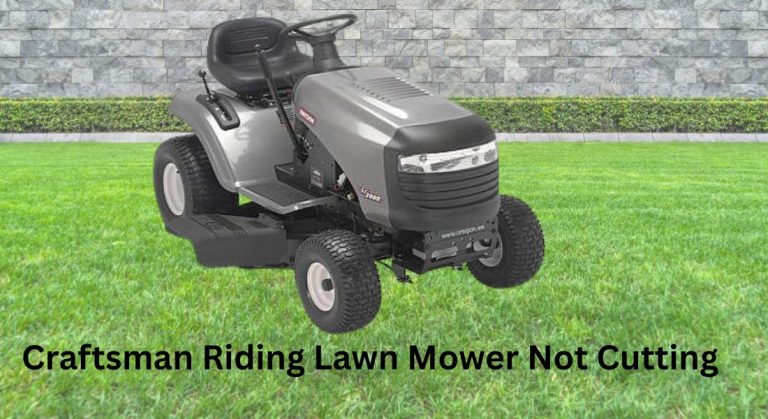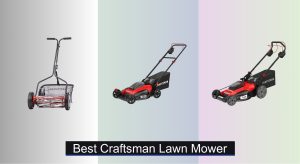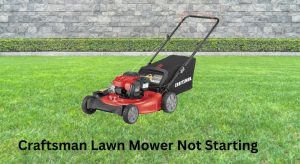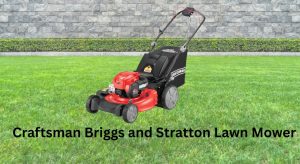When your Craftsman riding lawn mower isn’t cutting, it’s frustrating—especially when the grass is getting taller by the day. The quickest fix? Start by checking the deck engagement: make sure the PTO (blade engagement lever or switch) is on, the belt is intact and tight on all pulleys, and the blades aren’t dull or clogged with grass. Often, a worn belt or clogged deck is the simple reason your mower isn’t cutting.
In this complete guide, you’ll learn every common cause of a Craftsman riding mower not cutting and how to fix it—step by step. We’ll cover belt issues, blade problems, deck height, engine power, safety switches, and more. By the end, you’ll know how to diagnose and restore clean cutting performance, plus how to prevent the problem from coming back.
Common Causes of a Craftsman Riding Lawn Mower Not Cutting
- PTO not engaging (manual lever or electric switch failure)
- Broken, loose, or stretched deck belt
- Dull, bent, or incorrectly installed blades
- Deck packed with grass clippings or debris
- Deck height set too high or uneven deck leveling
- Engine running weak (clogged air filter, bad fuel, carburetor issue)
- Idler pulleys or spindle bearings worn out or seized
- Safety switch not allowing blade engagement
- Wet or overgrown grass conditions
- Wrong blades or wrong blade orientation
How to Fix a Craftsman Riding Lawn Mower Not Cutting

Method 1: Quick Checks and Easy Wins
Estimated time: 10–20 minutes
Diagnosing the Issue
- Is the PTO lever/switch engaging? Do you hear or feel the blades attempting to spin?
- Does the engine bog when you engage blades?
- Is the deck clogged or belt loose/off?
Fix Steps
- Park safely.
– Turn off engine, remove key, engage parking brake.
– Disconnect spark plug wire for safety. - Inspect the deck.
– Look underneath for packed grass. Scrape with a plastic putty knife or wooden stick.
– Check discharge chute for clogs. - Verify PTO engagement.
– If manual lever: ensure the cable moves the idler arm and tightens the belt.
– If electric PTO clutch (dashboard switch): listen for a “click” when switched on. No click can indicate a blown fuse, bad switch, or failed clutch. - Check the belt path and tension.
– Confirm belt is routed correctly around mandrel pulleys, idler pulleys, and engine pulley according to your model’s decal or manual.
– Look for cracks, glazing, fraying, or a loose fit. - Check blades visually.
– Ensure blades are not visibly bent and are mounted with the cutting edge facing the correct direction (usually the sail/wing faces up toward the deck).
Testing
- Reconnect spark plug, start the mower, engage PTO, and try cutting a small patch.
- If still not cutting or bogging, proceed to Method 2.
Method 2: Belt, Pulleys, and Deck Drive System
Estimated time: 30–60 minutes
A worn or misrouted belt is one of the top reasons a Craftsman mower won’t cut or won’t keep the blades spinning under load.
Diagnosing the Issue
- Symptoms of belt problems: blades engage weakly, slip under load, burning rubber smell, visible belt wear, belt jumps off.
- Spin pulleys by hand (engine off, plug wire disconnected). Any grinding, wobble, or stiffness indicates bad bearings.
Fix Steps
- Identify your model and belt.
– Locate model number (under seat or on frame). Look up correct deck belt part number (e.g., common Craftsman 42″ decks use belt sizes like 144959 or 954-04219A—verify for your model). - Remove the deck (if needed).
– Lower deck fully, release belt keepers, pop off the belt from engine pulley, disconnect hangers and linkages to slide deck out. - Replace or reinstall belt.
– Route the new belt exactly per diagram. Ensure belt runs inside belt keepers and around idlers correctly.
– Check idler spring—replace if stretched or broken; it maintains belt tension. - Inspect pulleys and spindles.
– Replace any pulley that wobbles, binds, or has a rough sound.
– Check spindle housings for play; replace bearings or entire spindle assembly if loose or noisy. - Verify belt tension and alignment.
– With PTO off, belt should be snug with proper spring tension. With PTO engaged, belt should be tight with no slack.
Testing
- Reinstall deck, reconnect belt to engine pulley.
- Engage PTO at half throttle, then full throttle. Blades should spin smoothly without squeal.
- Mow a small area to verify consistent cutting.
Method 3: Blade Condition, Orientation, and Deck Leveling
Estimated time: 30–90 minutes
Blades that are dull, bent, or installed upside-down will leave uncut grass or torn, ragged cuts.
Diagnosing the Issue
- Inspect cutting edges: dull edges feel rounded. Nicks or bends are common after striking sticks/rocks.
- Blade orientation: the “lift” wing faces upward toward the deck; cutting edge faces the front.
- Uneven cut or scalping may indicate an unlevel deck.
Fix Steps
- Remove blades safely.
– Block blade with a wood block. Use correct socket and torque for removal. - Sharpen or replace blades.
– Sharpen to a clean edge at ~30° angle; don’t overheat the metal.
– Balance each blade using a nail or cone balancer; an unbalanced blade causes vibration and spindle wear.
– Replace if bent, cracked, or excessively worn. Choose correct blades: standard, high-lift for bagging, or mulching blades matched to your deck. - Reinstall blades correctly.
– Ensure correct orientation. Torque to manufacturer spec (often 35–75 ft-lbs; check your manual). - Level the deck.
– Park on a flat surface. Inflate tires to spec first.
– Measure blade tip height (front vs. back and side-to-side). Typical spec: front about 1/8″–1/4″ lower than rear; sides equal.
– Adjust deck hangers/rods to achieve spec.
Testing
- Mow at full throttle. Evaluate stripe quality and cut evenness.
Method 4: Engine Power, PTO Clutch, and Safety Interlocks
Estimated time: 30–60 minutes
If the engine is weak or the PTO clutch isn’t supplying full engagement, the blades won’t maintain speed.
Diagnosing the Issue
- Engine bogs under light load: check air/fuel/spark.
- Electric PTO clutch does not “click” or slips: check voltage, gap, and wiring.
- PTO lever cable slack on manual systems: adjust cable.
Fix Steps
- Restore engine performance.
– Replace air filter if dirty.
– Install fresh fuel and add fuel system cleaner if fuel is old.
– Replace spark plug (correct type and gap per engine model, e.g., Briggs & Stratton or Kohler spec).
– Inspect and clean carburetor if surging or stalling persists. - Check safety switches.
– Seat switch, blade/pedal interlocks, and reverse mow operation (RMO) systems can prevent blade engagement.
– If the PTO won’t engage, test switches with a multimeter and inspect connectors. - Inspect and adjust PTO clutch.
– Electric clutch: verify 12V power at clutch connector when switched on. Inspect ground. Adjust air gap if adjustable (typical 0.012″–0.018″—check your clutch model).
– Manual PTO: ensure idler arm moves freely and spring provides strong tension; lubricate pivot if binding.
Testing
- At full throttle, engage PTO and cut a test strip. The blades should come up to speed quickly and maintain RPM without bogging.
How to Prevent Future Cutting Issues
- Clean the deck after each mow to prevent buildup and corrosion.
- Sharpen and balance blades every 25 hours or at least once per season.
- Replace deck belt every 1–3 seasons depending on use; inspect monthly.
- Keep tires at correct pressure to maintain deck level.
- Mow dry grass whenever possible; wet grass clogs decks and strains belts.
- Service engine annually: oil, filter, air filter, spark plug, fuel filter.
- Store under cover; moisture degrades belts and bearings.
Pro Tips
- Run engine at full throttle while mowing. Blade tip speed depends on engine RPM.
- Choose the right blade type: high-lift for bagging, mulching blades for fine clippings, standard for side discharge.
- Avoid cutting more than one-third of grass blade height at a time to reduce load and prevent clumping.
- Use a deck washout port sparingly; scraping by hand keeps the deck cleaner long term.
- Torque blade bolts properly; under-torqued bolts can cause wobble, over-torqued can damage spindles.
- If blades keep stopping, check idler spring length—weak springs cause chronic slippage.
- Replace worn blade spindle bearings at the first sign of play to protect the deck.
When to Call a Professional
- Electric PTO clutch failure or wiring faults you can’t trace
- Repeated belt throw-offs after proper routing and component replacement
- Severe deck damage (bent shell, cracked brackets)
- Engine surging or power loss that persists after basic tune-up
- Spindle replacement if you lack pullers/press tools
Typical costs:
– Deck belt: $25–$60
– Idler pulley: $15–$40 each
– Spindle assembly: $40–$120 each
– Electric PTO clutch: $150–$300
– Labor at a small engine shop: $80–$120/hour
Warranty considerations:
– Using OEM belts and blades is often required to maintain warranty coverage.
– Document maintenance (filters, belts, blades) with dates and receipts.
FAQs
Q: Why does my Craftsman mower run but not cut when I engage the blades?
A: Most commonly the deck belt is broken, off, or too loose to spin the blades. Check belt routing, belt wear, and PTO engagement. Also ensure blades are installed correctly and the deck isn’t clogged.
Q: My blades spin but the grass looks uncut. Why?
A: Dull or upside-down blades, very high grass, or deck height set too high can cause this. Sharpen/replace blades, confirm orientation, lower deck to an appropriate height, and mow at full throttle.
Q: The mower stalls when I engage the blades. What’s wrong?
A: Likely engine maintenance issues (dirty air filter, bad fuel, clogged carb) or blades/deck overloaded by heavy buildup or wet grass. Clean the deck, sharpen blades, and perform a tune-up.
Q: How tight should the deck belt be?
A: With PTO disengaged, the belt should be snug with spring tension; engaged, it should be taut with no slack. If you can easily push the belt off a pulley or see slack under load, replace the belt or spring.
Q: How often should I sharpen blades?
A: Every 25 hours of mowing or whenever you see torn tips, uneven cut, or dull edges. More often if mowing sandy soil or hitting debris.
Q: Can I mow wet grass?
A: You can, but it’s not recommended. Wet grass clumps, sticks to the deck, strains the belt, and leaves a poor cut. Wait until grass is dry for best results.
Q: Do I need OEM belts and blades?
A: Quality aftermarket parts can work, but OEM ensures correct length, width, and profile, which is critical for belt tracking and blade performance—especially under warranty.
Alternative Solutions
If your Craftsman riding lawn mower continues to struggle or your yard conditions are challenging, consider alternative approaches.
| Solution | Pros | Cons | Best For |
|---|---|---|---|
| Install mulching kit | Fine clippings, fewer clumps | Requires sharp blades, slower speed | Regular mowing, nutrient recycling |
| High-lift blades | Excellent lift and bagging | More engine load, louder | Bagging or tall, upright grasses |
| Deck baffle/cleanout upgrade | Reduces buildup | Added cost/installation | Damp climates, heavy growth |
| Outsource sharpening | Perfect edge and balance | Recurring cost | Users without tools/time |
| Upgrade to larger deck/tractor | Faster mowing, stronger drives | Higher cost, storage space | 1+ acre properties, heavy growth |
Get Your Craftsman Mower Cutting Again
By following this guide, you can restore your Craftsman riding lawn mower’s cutting performance:
– Verify PTO engagement and clear deck clogs
– Inspect and replace the deck belt, idlers, and springs
– Sharpen, balance, and correctly install blades
– Level the deck and set proper cutting height
– Tune the engine and check safety interlocks and PTO clutch
Tackle the quick checks first—many no-cut problems come down to a slipped belt or dull blades. With a little maintenance, you’ll be back to clean, even cuts in no time.
Still stuck or solved it already? Share your model number and what worked for you in the comments to help other Craftsman owners. Found this helpful? Bookmark it for your next tune-up.




